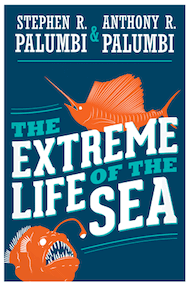By Louis J. Kern
The authors, a biologist (Stephen) and a popular science writer and novelist (Anthony), begin their tour of the ocean as the source of all earthly life with a quick overview of the transition from sterility to microbial archea to the earliest eukaryotic organisms and most of the animal phyla in the Cambrian Explosion (575- 510 million years ago). In the ensuing eons, five mass extinctions diverted the course of evolution of both pelagic and terrestrial life-forms. The most catastrophic were the third and fourth, collectively denominated the Permian-Triassic Extinction (251-200 million years ago) that resulted in the loss of 96% of all species on earth. Scientists believe that natural global warming (volcanism) caused this massive die-off. Currently, human-generated global warming, threatens a sixth extinction (See Elizabeth Kolbert, The Sixth Extinction: An Unnatural History, 2014) that scientists project by 2050 could kill off 25% of mammals, 20% of reptiles, 17% of birds, and massively alter the biodiversity of the sea.
Against the backdrop of a looming bio-collapse, the authors take us on an awe-inspiring tour of pelagic animals that populate the most extreme environments or have made the most extreme bodily adaptations to survive, ranging from survivors of all the extinction events like trilobites, horseshoe crabs, coelacanths and sharks to Blackfin icefish (that produce a natural antifreeze protein), anglerfish (giant females fused with blind parasitic males), and giant tube worms (that lack mouths and guts and are nourished solely by resident bacterial colonies). The survey of extreme oceanic life is a study of contrasts: the longest-lived, slowest reproducing versus those that live fast, pullulate extravagantly, and die young; organisms specifically adapted to the hottest versus the coldest environments; those adapted to the longest sustained journeys versus those capable of explosive speed over short distances. The wide range of ecological niches in the sea has elicited the amazing diversity of adaptations that characterize its biodiversity, and no single evolutionary strategy is universally the best.
The details of the adaptive strategies of various organisms are presented in fascinating detail. Take the case of the periwinkle snails that live at the limit of their intertidal range. Their brains are infected by a tiny parasitic worm (Gynaecotyla) that represses their fear of heights, causing them to climb high up stalks of grass where they are picked off by birds, thus facilitating the reproductive cycle of the worm. Nudibranchs, shell-less snails, prey on anemones by rubbing off the latters’ protective mucus, effectively disguising themselves as part of the anemone in order to feed on it at leisure. Nudibranchs also incorporate the anemone’s poisoned barbs (repurposed to the slug’s skin) as protection against predators. Then there’s the tiny jellyfish (Turritopsis nutricula) that is immortal. Through a process of transdifferentiation it repeatedly reverts to a juvenile state, being regenerated and sequentially reborn.
But despite this incredible diversity, its beauty and savagery, the sea’s is facing a state of emergency. The Palumbis assert that we have until 2050 to dramatically reduce carbon dioxide emissions; after 2100 if emissions aren’t controlled mass extinction becomes inevitable. What more can be done? Better land management and the reduction of toxic fertilizers that pollute seawater, fishing restraint, and the expansion of protected conservation areas will be needed as well, necessitating finely tuned international cooperation. There are no alternatives, for “the fate of the oceans has become our fate too, and we [are] out of easy ways to ensure that the future of the oceans is secure” (174).
Louis J. Kern (ΦBK, Clark University,1965) is professor emeritus of history at Hofstra University. Hofstra University is home to the Omega of New York chapter of Phi Beta Kappa.




